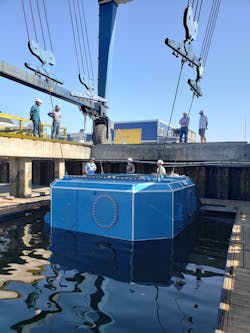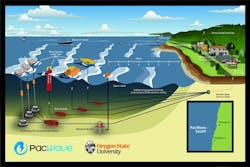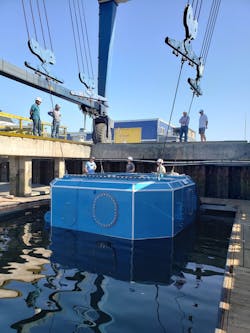Prospects for ocean-wave electricity generation joining the renewable energy portfolio of the future inched forward with a leading entrant’s recent completion of a pilot test of its technology.
CalWave Power Technologies, Inc., Oakland, Calif., said on September 1 that a submersible device it engineered to generate power from waves demonstrated strong viability during a 10-month deployment in San Diego coastal waters.
The device, employing the company’s patented xWave technology, generated power and data that was transmitted via undersea cable to the nearby Scripps Institution of Oceanography research pier. Preliminary test results confirmed many key aspects of the design, including demonstration of extensive uptime, the ability to withstand heavy seas, autonomous operation, corrosion resistance, and safety. Data from the test will be further analyzed, but the company said the pilot indicated its system is effective for overcoming the key challenges of performance, reliability, survivability, and cost.
With the device, dubbed x1, now decommissioned and giving engineers valuable information, CalWave’s next mission is to build a 100kW version for deployment at a groundbreaking wave energy test facility under construction off the Oregon coast. Its technology will join that of other developers at PacWave South, the nation’s first commercial-scale, fully permitted, grid-connected wave energy test site that will be operating in the Pacific Ocean, seven miles southwest of Newport, Ore. Developed by Oregon State University, the U.S. Department of Energy (DOE) and the state of Oregon, the $80-million project is structured to facilitate the simultaneous study of multiple wave energy generation concepts and give developers a quicker pathway to testing their designs.
PacWave South is slowly taking shape, with construction having begun in June 2021 and extensive underground work involving the laying of conduit standing completed in early 2022. The latest project timeline, according to PacWave deputy director Dan Hellin, doesn’t have any testing starting earlier than 2024.
“We are currently in the process of hiring a firm to build our terrestrial Utility Connection & Monitoring Facility (UCMF),” Hellin says. “The contract has not yet been awarded, but that should happen in the next couple of months. Work on that will likely start later this year and run through most of 2023.
“The other major piece of the project is the subsea cable supply and install. We are just in the process of contracting for that work and expect the subsea cables to be installed in 2024. That will allow us to start grid connected testing in 2025. Non-grid connected testing may well start before that as those would be smaller devices that could be deployed without interfering with cable lay operations.”
In the meantime, CalWave and other technology developers that have received DOE funding to advance wave energy production will be working on designs for the eventual PacWave deployment. CalWave got DOE support doled out widely in 2017 for its recently completed San Diego test and was awarded $7.5 million by DOE in January to further develop its xWave technology for use on local energy grids and microgrids, part of which will fund its PacWave entry.
DOE has deepened its interest in wave energy as part of its effort to promote exploration of expanded renewable energy concepts. It says wave energy is abundant and unique in its high degree of predictability, opening the door to development that could be located close to load centers. If only a third of available wave energy near Pacific states was developed, it could meet up to 30% of West Coast electricity demand, it says. Practically, however, wave energy production of any consequence is likely decades off. But the starting gun in the race for practical approaches appears to have sounded.
Tom Zind is a freelance writer based in Lees Summit, Mo. He can be reached at [email protected].
About the Author
Tom Zind
Freelance Writer
Zind is a freelance writer based in Lee’s Summit, Mo. He can be reached at [email protected].


